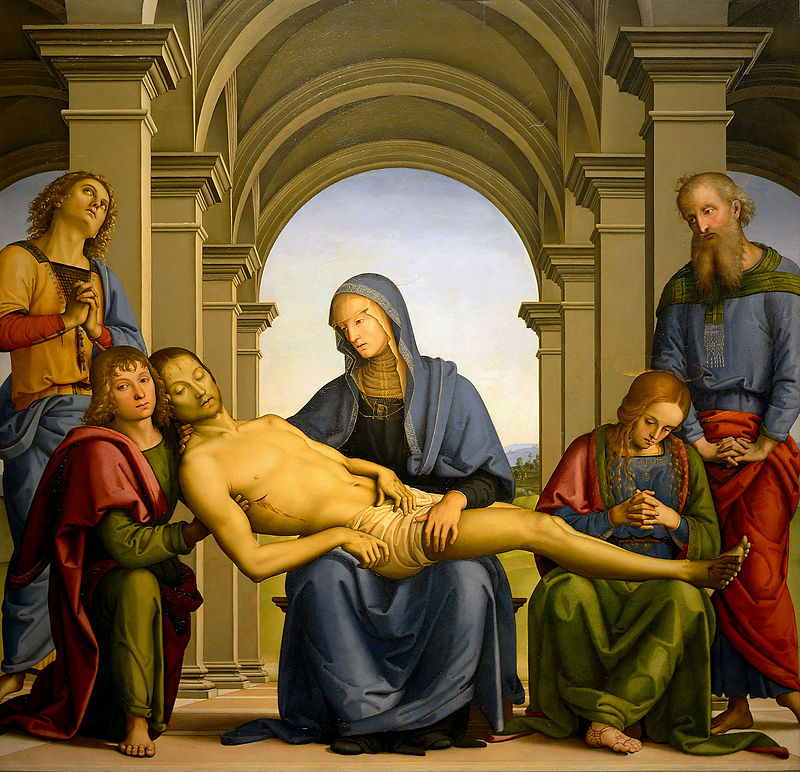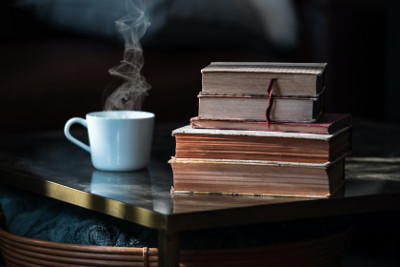After Perugino’s Pietà
Denise O’Hagan
And in the granite tenderness
with which she lays her hand
over his long pale body laid out
stiffly across her knees, is written
every mother’s deepest fear, that it should
come to this. She’s set apart;
the portico around her makes sure of that,
framing her in air. And yet—
There’s something monolithic
about her seated, blue-robed form
and sturdy spaced-apart knees, though
her left hand curling his thigh is
fine boned, her little finger curving out and in
like yours or mine; sometimes,
in these great works of art, it is
the detail that we relate to.

Aware of her, we yet can’t bring
ourselves to face her. Instead, our eye
detours to the russet-haired and sandalled
woman at her left, her fingers
steepling the bleached blades of his shins:
this weeping Mary Magdalene,
cheeks reddened and glistening tears pearling,
dares expose her undiluted grief.
Here’s what we notice: the hair of St John
brushing the bleeding face of Christ,
Nicodemus’ eyes raised heavenwards
as an aged Joseph of Arimathea rests
the hands that helped to bury him.
But we are putty in the artist’s hands,
and party to his formal composition,
and drag our eyes at last to hers.
If we hoped to read them, we may think again.
She’s composed, has been for centuries,
and we are left to wrestle with the knowledge
that this was always meant to be,
that part of her would have it no other way;
the other part is left for us to fathom how
a blow unthinkable in human terms
can in an oil painting be transformed.
Note
This poem was inspired by the painting of the Pietà by Pietro Perugino, the Italian Renaissance artist whose compositions are known for their classicism and formal symmetry. Like the Michelangelo sculpture of the same name, the painting depicts the Virgin Mary mourning over the body of her son. Executed c. 1483–1493, it was originally painted for church of San Giusto alle Mura, outside Florence, and is now in the Uffizi.
Nicodemus, a wealthy member of the Sanhedrin who studied with Jesus, assisted in his burial, supplying myrrh and aloes as embalming spices. Joseph of Arimathea, a disciple of Jesus, is known as being the man who obtained permission from Pontius Pilate to remove the body of Jesus after his crucifixion, and purchased linen in which to bury him. Both Nicodemus and Joseph are venerated as saints in the Catholic and Orthodox Churches.
‘Pietà’ was awarded second prize in the International Proverse Poetry Prize (Hong Kong), 27 April 2022, and was first published in Mingled Voices 7, International Proverse Poetry Prize Anthology 2022, ed. G & V Bickley (Proverse Hong Kong, April 2023).
Bio
Denise O’Hagan is a Sydney-based editor and poet, born in Rome, with a background in commercial book publishing in the UK and Australia. Recipient of the Dalkey Poetry Prize, her work is published internationally and has been shortlisted in the ACU Poetry Prize, the Robert Graves Poetry Prize and the Plough Writing Prize. Her poetry collections include The Beating Heart, shortlisted for Society of Women Writers NSW Book Awards (2022), and Anamnesis, category finalist in the Eric Hoffer Book Award (2023).






